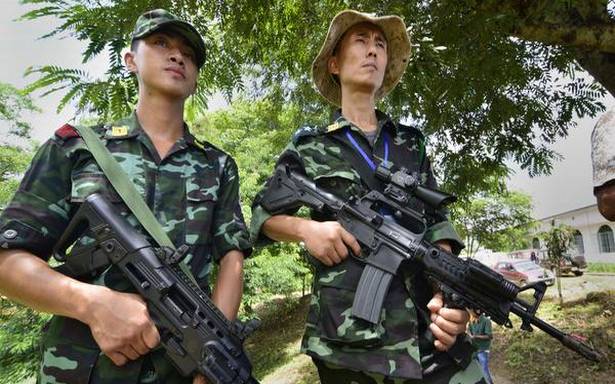The NSCN (Khaplang-Yung Aung) is in sync with a unit of NSCN (Isak-Muivah), said to operate independently of the parent organisation headquartered in Nagaland
The Isak-Muivah faction of the National Socialist Council of Nagaland or NSCN (I-M) is arguably the most organised and disciplined of the extremist groups — active or disbanded — in the northeast.
But a maverick top gun of the outfit, known to offer his services for political kills, has been operating independently in sync with the NSCN (Khaplang-Yung Aung) to gain ground in southern Arunachal Pradesh, officials said.
Two years after the NSCN split into the Isak-Muivah and Khaplang groups in 1988, the latter ventured into the Changlang, Longding and Tirap districts of Arunachal Pradesh.
The NSCN (Khaplang) capitalised on the geographical proximity of these districts — they adjoin the Nagaland and Sagaing area of Myanmar where the outfit is based — as well as tribal affinity to entrench itself.
The Nocte and Wancho communities of Arunachal Pradesh share a cultural affinity with the Konyaks of Nagaland’s Mon and Tuensang districts, once comprising the main fighting force of NSCN (K). The Tangsas, on the other hand, live on either side of the border separating Arunachal Pradesh and Myanmar.
The NSCN (I-M) began penetrating southern Arunachal Pradesh about two decades ago as the NSCN (K) kept splitting into factions such as NSCN (Unification), NSCN (Reformation). These became bit players after Yung Aung (YA) took over the NSCN (K) following the death of its patriarch Shangnyu Shangwang Khaplang died in June 2017.
Wanted for assassination
“The NSCN (K) factions and the southern Arunachal unit of NSCN (I-M) led by the self-styled major-general Rockwang Absalom Tangkhul had been fighting for territorial control. But the NSCN (K-YA) and Absalom struck a deal for peaceful co-existence, although they have not gone for joint operations,” a security force officer said on condition of anonymity.
The factional clashes in Arunachal Pradesh ended by 2014 and both the I-M and K-YA have been taxing every village, house and shop in areas under their respective control.
The understanding between the two groups has been mutually beneficial. While K-YA has dominance in Longding district and has yielded some space to I-M in Changlang, the I-M enjoys more territorial control in Tirap.
According to Armed Forces officials, the NSCN (K-YA)’s activities on the Indian side have suffered after key leaders such as Khango Konyak, Nyemlang Konyak and Niki Sumi crossed over with at least 90 loyalists and joined the peace process with New Delhi.
Absalom and his band of 180-200 fighters have reportedly been taking advantage of the unwritten agreement as well as a weakening NSCN (K-YA) to cover more ground. Much of his activities do not have the sanction of the NSCN (I-M) leadership based at Hebron near Nagaland’s commercial hub Dimapur, officials say.
“The NSCN (I-M) has been maintaining distance from him because of the National Investigation Agency (NIA) case against him,” an official said.
The NIA had in September 2020 announced a cash award for information on Absalom, declared absconding with four other others wanted in the assassination of National People’s Party MLA Tirong Aboh and 10 others in May 2019.
Source: Read Full Article

